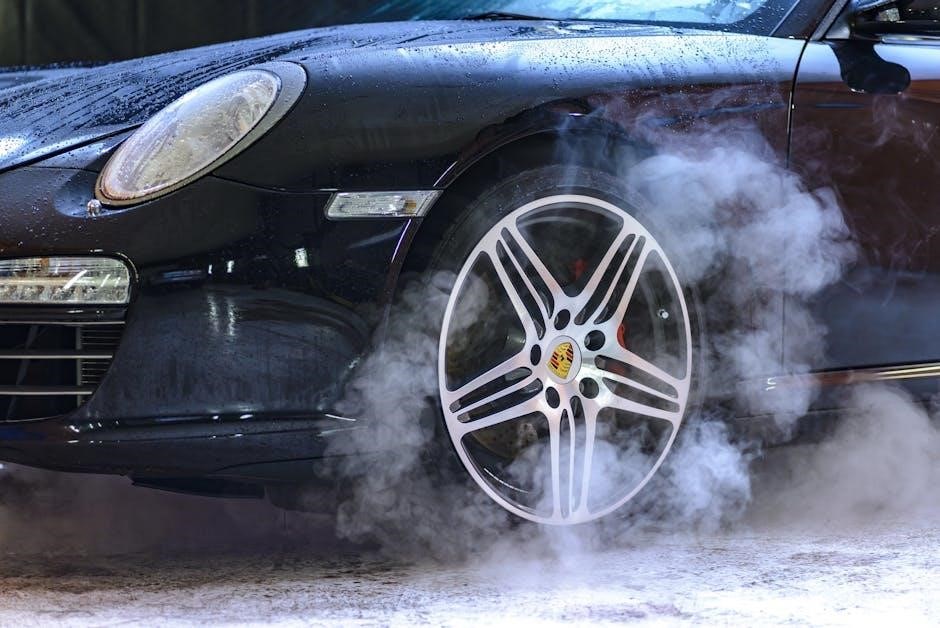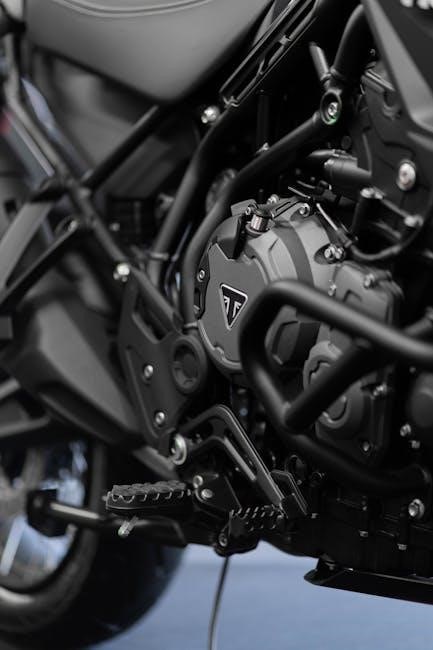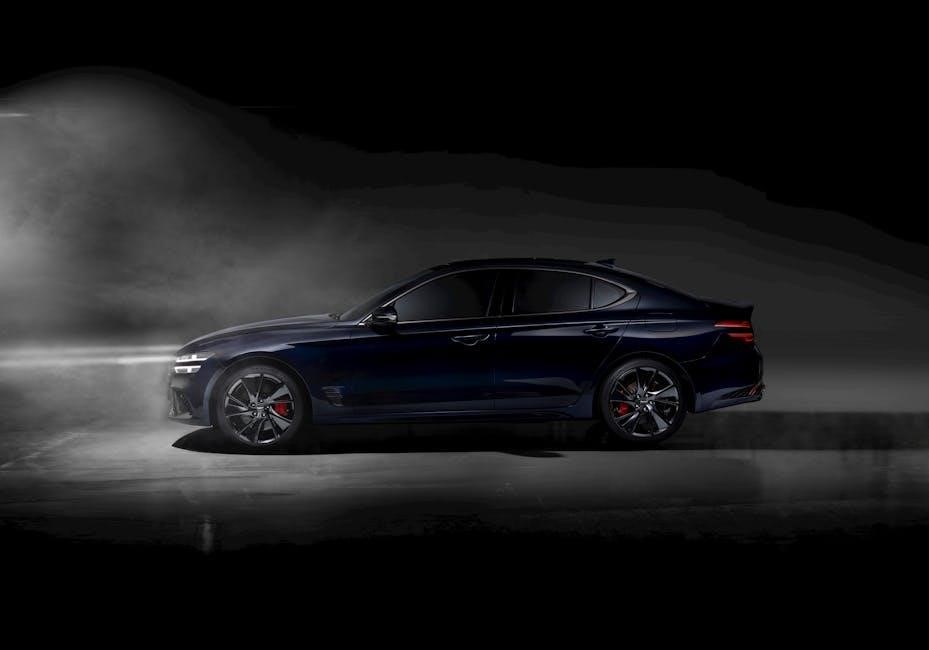manual brakes vs power brakes
Manual and power brakes differ in design and functionality‚ with power brakes using a booster for reduced pedal effort‚ while manual brakes rely solely on driver input for stopping power.
Overview of Brake Systems
Brake systems are essential for vehicle safety‚ enabling controlled deceleration and stopping. Manual brakes operate solely through mechanical linkages‚ relying on the driver’s physical effort to apply pressure to the master cylinder‚ which then distributes hydraulic force to the wheels. In contrast‚ power brakes incorporate a brake booster‚ utilizing engine vacuum or hydraulic assistance to reduce pedal effort‚ making braking easier and more efficient. Both systems ultimately aim to convert non-hydraulic pressure from the pedal into hydraulic pressure to engage the brakes. Understanding these systems is crucial for maintaining vehicle performance and safety‚ as each has distinct mechanisms and requirements for optimal functionality.

Importance of Understanding Brake Types
Understanding the differences between manual and power brakes is crucial for drivers and automotive enthusiasts. Manual brakes require more physical effort but offer simplicity and reliability‚ making them ideal for racing or lightweight vehicles. Power brakes‚ with their booster technology‚ provide easier pedal operation‚ enhancing comfort and control‚ especially in heavy vehicles or for drivers with mobility limitations. Recognizing these distinctions helps in making informed decisions during vehicle modifications or upgrades. Proper knowledge also ensures maintenance and troubleshooting are performed effectively‚ minimizing risks of brake failure. Whether prioritizing performance‚ ease of use‚ or specific driving conditions‚ comprehending brake types is essential for optimal vehicle operation and safety.
How Manual Brakes Work
Manual brakes operate solely on driver input‚ using a brake pedal connected to a master cylinder‚ which applies pressure to brake shoes or pads at the wheels directly.
Mechanical Components of Manual Brakes
Manual brakes consist of a brake pedal‚ master cylinder‚ brake lines‚ and either drum or disc brakes. The pedal is connected to the master cylinder‚ which converts non-hydraulic pedal pressure into hydraulic pressure. This pressure is then transmitted through brake lines to the wheels‚ where brake shoes (in drum systems) or pads (in disc systems) apply friction to slow the vehicle. Unlike power brakes‚ manual systems lack a booster‚ relying entirely on the driver’s leg strength for operation. The simplicity of manual brakes reduces potential failure points but increases the effort required to stop the vehicle‚ making them less common in modern vehicles.
Advantages of Manual Brakes
Manual brakes offer simplicity and reliability due to fewer components‚ reducing the risk of mechanical failure. They are lightweight and cost-effective‚ making them ideal for racing or lightweight vehicles. Without a booster‚ manual brakes provide a direct feel‚ allowing drivers to sense braking force better. Additionally‚ they are easier to maintain and repair‚ as there are no vacuum hoses or complex systems to manage. This straightforward design also means less potential for leaks or system failures compared to power brakes. However‚ the trade-off is increased pedal effort‚ which can be tiresome in heavy traffic. Despite this‚ manual brakes are favored in certain niche applications where simplicity and driver feedback are prioritized over convenience.
Disadvantages of Manual Brakes
Manual brakes require significantly more pedal effort and physical strength‚ making them less convenient for everyday driving. This increased effort can lead to driver fatigue‚ especially in heavy traffic or frequent stopping situations. Additionally‚ manual brakes often result in longer stopping distances compared to power-assisted systems‚ as the driver must apply more force and time to achieve the same level of deceleration. They also lack the precision and ease of control offered by power brakes‚ which can be particularly challenging for inexperienced drivers. Furthermore‚ manual brakes are not well-suited for vehicles with heavier gross weights or those requiring rapid‚ precise braking. Overall‚ while manual brakes offer simplicity‚ their drawbacks in comfort and performance make them less practical for most modern driving scenarios.

How Power Brakes Work
Power brakes use a brake booster‚ powered by engine vacuum or an electric pump‚ to amplify pedal force‚ reducing effort and enhancing stopping efficiency and control.
Role of the Brake Booster in Power Brakes

The brake booster amplifies the force applied to the brake pedal by utilizing engine vacuum or an electric motor‚ reducing pedal effort and enabling easier‚ more efficient braking.
Advantages of Power Brakes
Power brakes offer significant advantages‚ including reduced pedal effort‚ making braking easier for drivers‚ especially in heavy vehicles or for those with limited strength. They enhance stopping efficiency‚ providing faster and more controlled deceleration.
Disadvantages of Power Brakes
Power brakes depend on engine vacuum or an electric pump‚ which can fail‚ leaving the driver with increased pedal effort. They are more complex and costly to maintain compared to manual systems.

Key Differences Between Manual and Power Brakes
Manual brakes require more pedal effort and offer a firmer feel‚ while power brakes provide easier operation but rely on additional components like the brake booster.
pedal Effort and Feel
Pedal Effort and Feel
Manual brakes demand significantly more pedal effort‚ requiring the driver to apply greater force‚ which can lead to fatigue during extended or heavy stop-and-go driving. This increased effort is due to the absence of a brake booster‚ making the pedal feel firmer and more direct. In contrast‚ power brakes utilize a booster that amplifies the force applied to the pedal‚ resulting in a lighter and more comfortable feel. This reduction in effort is particularly beneficial for drivers who prefer a smoother‚ less physically demanding braking experience. However‚ some drivers prefer the tactile feedback of manual brakes‚ as they provide a more precise connection to the vehicle’s stopping capabilities. The choice between the two often comes down to personal preference and driving habits.
Stopping Power and Efficiency
Manual brakes rely entirely on the driver’s leg strength and mechanical advantage‚ requiring more physical effort but providing consistent stopping power. They are less complex‚ with fewer components‚ which can make them more reliable in the event of system failures. Power brakes‚ however‚ utilize a booster to amplify braking force‚ resulting in greater stopping efficiency with less pedal effort. This makes them particularly effective in heavy vehicles or for drivers who need assistance with frequent or emergency stops. While manual brakes may lack the enhanced performance of power brakes‚ they offer simplicity and direct control. The choice between the two often depends on the vehicle’s weight‚ driving conditions‚ and the driver’s preference for ease of use versus mechanical simplicity.
System Complexity and Maintenance
Manual brake systems are simpler in design‚ with fewer components‚ making them easier to maintain and repair. They lack the booster and vacuum systems found in power brakes‚ reducing the risk of complex failures. Power brakes‚ while more efficient‚ introduce additional components like the brake booster and vacuum lines‚ which require regular inspection and maintenance. Manual brakes are less prone to issues like fluid leaks or booster failure‚ offering reliability in straightforward setups. However‚ power brakes‚ despite their complexity‚ often provide better performance and driver comfort. The choice between the two systems depends on the balance between simplicity‚ maintenance preferences‚ and desired braking performance. Manual brakes are ideal for lightweight vehicles or drivers prioritizing mechanical simplicity‚ while power brakes suit heavier vehicles or those needing enhanced braking assistance.

